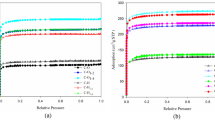Abstract
Waterlogged archaeological woods (Pinus pinaster, Ulmus cf. minor and Fagus sylvatica L.) were consolidated by using Colophony, Rosin 100, and a mixture of Poly(ethylene) glycol (PEG) 3000 and Poly(propylene) glycol (PPG) 425. The efficiency of the consolidants was estimated by determining the content entrapped into the cavity of degraded wood. For this purpose, thermogravimetry was demonstrated to be a reliable tool. In the case that the polymeric mixture was used for impregnation, it was also possible to discriminate the amount of PEG 3000 from that of PPG 425 captured by the wood capillaries. Regardless of the wood nature, all the consolidants were present in treated samples in large amount (at least 70% w/w). Thermogravimetric results were in agreement with those calculated by using the wood degradation degree and composition of the consolidant mixture. One of the advantages of using this technique consists into requiring very small amounts (a few mg) of sample against the grams necessary for the conventional experiments.






Similar content being viewed by others
References
Chelazzi D, Giorgi R, Baglioni P. Nanotechnology for Vasa wood de-acidification. Macromol Symp. 2006;238:30–6.
Giachi G, Bettazzi F, Chimichi S, Staccioli G. Chemical characterisation of degraded wood in ships discovered in a recent excavation of the Etruscan and Roman harbour of Pisa. J Cult Herit. 2003;4:75–83.
Capretti C, Macchioni N, Pizzo B, Galotta G, Giachi G, Giampaola D. The characterization of waterlogged archaeological wood: the three roman ships in Naples (Italy). Archaeometry. 2008;50:855–76.
Jordan BA. Site characteristics impacting the survival of historic waterlogged wood: a review. Int Biodeterior Biodegrad. 2001;47:47–54.
Giachi G, Capretti C, Macchioni N, Pizzo B, Donato ID. A methodological approach in the evaluation of efficacy of treatment for the dimensional stabilization of waterlogged archaeological wood. J Cult Herit. 2010;11:91–101.
Christensen BB. The conservation of waterlogged wood in the National Museum of Denmark. Copenhagen: Museum of Denmark; 1970.
Hedges JL. The chemistry of archaeological wood In: Rowell RM, Barbour RJ, editors. Archaeological wood: properties, chemistry, and preservation. Advances in chemistry Series, vol. 225. Washington: American Chemical Society; 1990.
Gelbrich J, Mai C, Militz H. Chemical changes in wood degraded by bacteria. Int Biodeterior Biodegrad. 2008;61:24–32.
Bardet M, Foray MF, Maron S, Goncalves P, Trân QK. Characterization of wood components of Portuguese medieval dugout canoes with high-resolution solid-state NMR. Carbohydr Polym. 2004;57:419–24.
Jensen P, Gregory DJ. Selected physical parameters to characterize the state of preservation of waterlogged archaeological wood: a practical guide for their determination. J Archaeol Sci. 2006;33:551–9.
Mortensen MN, Egsgaard H, Hvilsted S, Shashoua Y, Glastrup J. Characterisation of the polyethylene glycol impregnation of the Swedish warship Vasa and one of the Danish Skuldelev Viking ships. J Archaeol Sci. 2007;34:1211–8.
Wang Y, Schniewind AP. Consolidation of deteriorated wood with soluble resins. J Am Inst Conserv. 1985;24:77–91.
Franceschi E, Cascone I, Nole D. Thermal, XRD and spectrophotometric study on artificially degraded woods. J Therm Anal Calorim. 2008;91:119–23.
Streibel T, Geißler R, Saraji-Bozorgzad M, Sklorz M, Kaisersberger E, Denner T, et al. Evolved gas analysis (EGA) in TG and DSC with single photon ionisation mass spectrometry (SPI-MS): molecular organic signatures from pyrolysis of soft and hard wood, coal, crude oil and ABS polymer. J Therm Anal Calorim. 2009;96:795–804.
Lin Q, Su W, Xie Y. Effect of rosin to coal-tar pich on carbonization behavior and optical texture of resultant semicokes. J Anal Appl Pyr. 2009;86:8–13.
UNI 11205:2007, Beni culturali-legno di interesse archeologico e archeobotanico—linee guida per la caratterizzazione. Milano: UNI; 2007.
Schoch W, Heller I, Schweingruber FH, Kienast, F. Wood anatomy of central European Species. 2004. http://www.woodanatomy.ch.
TAPPI. Standards technical association of pulp and paper industry. New York: TAPPI; 1996–1997.
Browning BL. Methods of wood chemistry, vol. I, II. New York: Interscience Publishers/Wiley; 1967.
Sivalingam G, Karthik R, Madras G. Blends of poly(ε-caprolactone) and poly(vinyl acetate):mechanical properties and thermal degradation. Polym Degrad Stab. 2004;84:345–51.
Lazzara G, Milioto S. Copolymer-cyclodextrin inclusion complexes in water and in the solid state. A physico-chemical study. J Phys Chem B. 2008;112:11887–951.
Sivalingam G, Madras G. Thermal degradation of binary physical mixtures and copolymers of poly(e-caprolactone), poly(d,l-lactide), poly(glycolide). Polym Degrad Stab. 2004;84:393–8.
Lazzara G, Milioto S, Gradzielski M, Prevost S. Small angle neutron scattering, X-ray diffraction, differential scanning calorimetry, and thermogravimetry studies to characterize the properties of clay nanocomposites. J Phys Chem C. 2009;113:12213–9.
Bardet M, Gerbaud G, Trân QK, Hediger S. Study of interactions between polyethylene glycol and archaeological wood components by 13C high-resolution solid-state CP-MAS NMR. J Archaeol Sci. 2007;34:1670–6.
Acknowledgements
The work was financially supported by the University of Palermo. We thank the Fondazione Banco di Sicilia (Palermo, Italy) which cofinanced the TGA Q5000 IR apparatus (Convenzione PR 4.b/08).
Author information
Authors and Affiliations
Corresponding author
Rights and permissions
About this article
Cite this article
Donato, D.I., Lazzara, G. & Milioto, S. Thermogravimetric analysis. J Therm Anal Calorim 101, 1085–1091 (2010). https://doi.org/10.1007/s10973-010-0717-9
Received:
Accepted:
Published:
Issue Date:
DOI: https://doi.org/10.1007/s10973-010-0717-9




